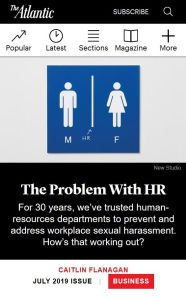Join getAbstract to access the summary!

Join getAbstract to access the summary!
Caitlin Flanagan
The Problem with HR
For 30 years, we’ve trusted human-resources departments to prevent and address workplace sexual harassment. How’s that working out?
The Atlantic, 2019
What's inside?
Campaigns against sexual harassment have failed to produce a more respectful and safe work environment for women.
Recommendation
Since the 1990s, HR departments have been busy educating employees about sexual harassment and drawing up companywide policies for proper conduct. These efforts, however, have largely failed to produce a more respectful and safe work environment. The Harvey Weinstein scandal, followed by the #MeToo movement, are testament to that. Writing for The Atlantic, Caitlin Flanagan seeks to find out what went wrong. Her analysis provides important insights for HR professionals and anyone interested in workplace discrimination issues.
Summary
About the Author
Caitlin Flanagan is a contributing editor at The Atlantic. She is the author of Girl Land and To Hell With All That.
















Comment on this summary